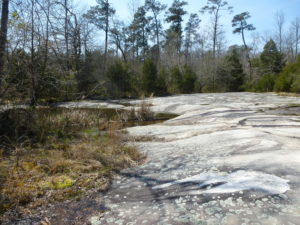
“The closer you get to real matter, rock air fire and wood, boy, the more spiritual the world is.” -Jack Kerouac
We admire the beauty of mountains and rocky outcrops and feel called to spiritual heights by their magnificence. Many of these places are laced with legends that reveal and animate their particular qualities and powers. In most land-based indigenous cultures certain mountains are revered as sacred ground and are central to their myths and stories, as is Chief Mountain (Ninaistako) in Montana for the Blackfeet. Here in the Smokies, Clingmans Dome (Kuwa’hi), the second highest peak in the East, is sacred to the Cherokee.
In Ireland there are countless myths of the Ancient One, the Cailleach, who is credited with creating the mountains themselves. In Scotland where she makes the weather, as mountains make their own weather, she and the Highlands are so layered with meaning they are barely distinguishable. In Ireland virtually every seemingly insignificant rocky cove or bouldered height is named, and many carry “stories of place,” which are collected in the early ‘lore of places,’ the Dindshenchas.
Some of these, to be sure, are mythic tales of heroic happenings in high places, or about a sainted hermit, say, whose banishment of a king for bad behavior left those curious markings on a certain slab of rock. But many are simple folktales that recall events that occurred to very ordinary people in very local places. Story serves to bond people to place. Some of these stories also illustrate how rock, too, is alive with meaning.
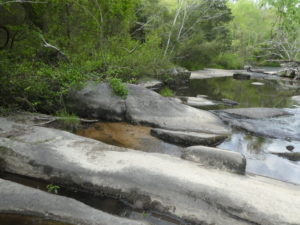
We don’t need to go to, say, Mt. Shasta to experience spirit permeating rock. We can experience the bedrock of the landscape where we live as sacred ground. Besides, they are all connected below, anyway! If our local ground is not held sacred, try to locate some rocky places about which legends and stories are told. We can listen for stories the rocks are telling now.
My family doesn’t live in the glorious mountains of North Carolina with their spectacular granite domes and waterfalls. We live in the Piedmont which, it turns out, has a fascinatingly diverse geology. As locavores eat local foods, I am nourished by the various flavors of our unique rocky landscapes. Most of the indigenous cultures that lived here in the Piedmont were wiped out so long ago the traditional stories of these places are lost. Some are, no doubt, still treasured and told, while others are being re-created, rather re-heard, as their descendants listen anew to the land speaking to them. I long to know the significance of these rocky Piedmont landscapes to the ancestral people who lived here within them. Some of these places have qualities that seem so sacred, surely they would have been honored by people prone to pray in them. Others have such presence that surely stories about them would have been told.
As we know only too well, we, the colonists who took over this land, did not see its sacredness. Spirit was inside a church and above it, not in the trees and the ground below from which they grow. In the quest to do my small part to reconnect us to a resacralized land, I seek opportunities to pilgrimage to these rather hidden sites, to savor and give thanks for their beauty. I ask what makes a place sacred? And why is not this place or that place in all its particularity revered? We know that one quality that sometimes signals a place’s sacredness is that there is something unusual about it.

Granite “flatrocks” are, indeed, strange beings. In the mountains, when granite exfoliates, it creates magnificent domes. In the Piedmont it forms smooth, rolling flatrock. Mitchell Mill State Natural Area protects 105 acres of granite flatrock and its surrounding wooded glades. It is part of the Rolesville Pluton, a giant beached whale of granite bedrock thirty miles long, fifteen miles wide and about 50,000 feet deep. It surfaces to breathe in a small number of other locales along the way.
This pluton is part of several that converge and is so large it is called a batholith. When the ancient African continent of Gondwana collided with North America during the formation of the supercontinent Pangea, plutons formed by the “ascent of relatively buoyant magma,” which, rather than erupting in a volcano, slowed down and cooled underground. This continental granite, in turn, floats on top of the oceanic basalt below.
Exposed rocks that have broken away from the underlying bedrock seem to rise to the surface throughout the glades. Geologists call them “float rocks.” Hikers call the smooth, rounded outcrops “whalebacks.” Nearby, one particular cetacean-sized boulder rises up taller and wider than the rest, and a fascinating tale is told about it and a certain senator who is buried there.
Like a pod of these giant gray beings, other granite flatrocks swim along the fall-line between the Piedmont and Coastal Plain from Alabama to Virginia, but the Rolesville Pluton in North Carolina is the largest behemoth in the east.
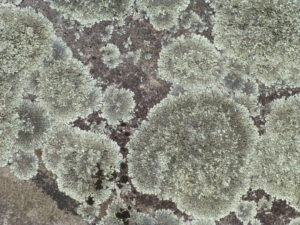

The broad expanse of undulating granite appears uniformly gray, but on closer look is pink with feldspar, shiny with mica and speckled white with quartz. Round filigree lichens, as if stenciled from doilies, decorate the bare rock face. They secrete acids that weather the rock into tiny grains. Dotted around the lichens are variously sized mounds of Grimmia, a moss that is black when dry, but instantly expands and turns dark green when moistened. As these mosses trap rain-washed sand grains and blown-in dust, thin soil gradually begins to form in a process called primary succession. Primary succession “inducts previously barren surfaces into the society of life,” says naturalist Michael Godfrey. Eventually, after many years, sometimes centuries, there is enough soil to support other mosses, then small plants.

Granite flatrocks are sometimes called “nature’s rock gardens” because of the spectacular natural arrangements of colorful flowers, bright green mosses, and pink spike moss that grow in sculpted mats of soil that has accumulated on the surface and in the shallow depressions scooped out of the otherwise smooth, sweeping expanse of rock. These gardens flow along the open slope of the rock or gather in hidden rooms to be discovered.
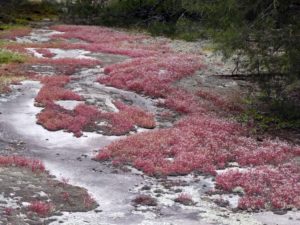
In Spring, around the edges of the floral mats in the shallowest soil grow annuals that have adapted themselves to life on hot rock. Thousands of bright red sedums called Elf Orpines (Diamopha smallii) frame the various garden plots. These grow nowhere else but on fall-line flatrocks. Only three inches tall, their delicate pink flowers are pollinated by ants. As the ants get nectar from the flowers they inadvertently drag pollen to nearby flowers.
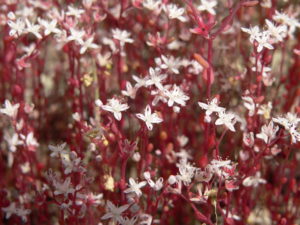

These flowery islands are often surrounded by so many white foliose lichens as to appear snow-covered.

In brilliant mats of moss grow sprays of white Appalachian Stitchwort (Minuartia glabra). Its leaves are so tiny they don’t get burned up by the sun. Yellow, long-stemmed Dwarf Dandelions (Krigia virginica) sway within the white. Occasionally we see succulent, light pink Small’s Purslane (Portulaca smallii) a rare, protected plant. Towards the middle of the mats where deeper soil has accumulated lush mosses thrive and retain moisture for grasses to begin to take hold.
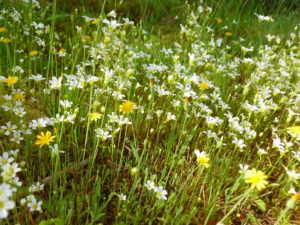
On the edges of the rock, where dampness seeps from the wooded glade, and the soil is wetter, great puffs of reindeer lichens and tall, luxuriant beds of dark green haircap moss form their own arrangements. Colorful peat mosses and wetland sedges adorn the even seepier places. Because of the relatively small size of these plant beds and the fragility of these habitats, many plants on granite plutons are rare, threatened, or endangered. Some are endemic, which means they can grow nowhere else on the planet other than on these flatrocks.
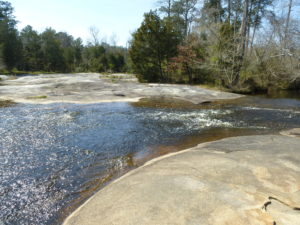
There is an aquatic presence as well. The Rolesville Pluton is the only one that has a river flowing through it. The Little River runs along the rock at the border of the preserve and eventually into the Neuse River. It is home to an endangered salamander called the Neuse River Water Dog. A tributary, Cedar Prong Creek, flows over the flatrock. Upstream there is a huge beaver dam creating a large, mysterious wetland. Water-sculpted rock bowls, called “solution pools,” because they are formed as water dissolves the rock, fill with rainwater, creating small ephemeral ponds that are animated with frogs, salamanders, and crayfish. Lizards bask on the warm rocks.
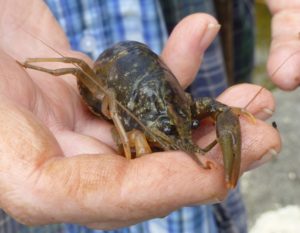
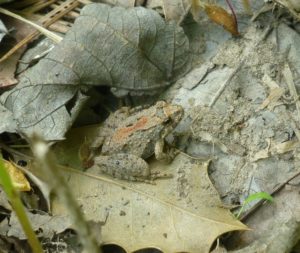
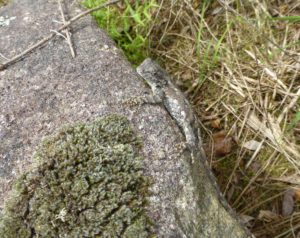
It’s wonderful to explore these places with people who share a desire for the intimacy of meeting each species, seeing how they live together, and learning about their ecological roles in this particular habitat community. Our enthusiasm peaks when at another outcrop we see luna moths mating.
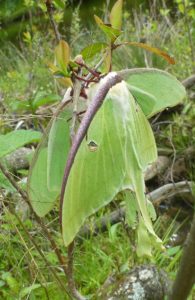
On a warm early spring day it is delicious to sit in the sun on the warm rock with our feet in the cold creek, tea-colored by the cedars, swiftly flowing over the rock, admiring the saxifrage flowers that color the transitional edge white. In later spring these are replaced by white fringe trees. Eastern Red cedars have a propensity to grow along the edges between rock and glade, such that some of these granitic places are locally called “cedar rocks.” We are delighted to catch a glimpse of a pretty green butterfly called a Juniper Hairstreak nectaring on the saxifrage. It is entirely dependent for its life cycle on red cedars.
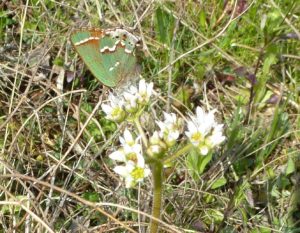

Ranger Orcutt tells us the history of the colonial community that once thrived here, of the mill on the river and the plantations that surrounded it. But it’s his telling of the story of the young senator who loved the rock, recounted in 1940 by Georgiana Norwood, daughter of one of the family’s slaves, which was repeated down through the generations, that binds me to this place.*
William Andrew Jeffreys (1817-1845) was the great-grandson of the first documented owner of the property. He lived a short distance away from Mitchell Mill and loved to play among the rocks as a child. He became a lawyer and was a staunch Democrat. He was elected to the NC Senate in 1844. Shortly after he was elected he fell ill with a fever. He told his father that if he should die he wanted to be buried in the huge rock that he loved where he had played. This particular granite boulder is about twelve feet tall and twenty feet in diameter and rises like a great gray whale breaching from the sea of the surrounding flatrock and farmland. Believing that his son would recover, his father agreed to his wish. But, within a few days, 28 year old William died of typhoid fever.
To honor his son’s death-bed wish, William’s father traveled to the state capitol and hired the Scottish stone mason who had worked on constructing the new capitol building (after the first one burned down) to prepare his son’s tomb. It took eleven months for the mason to chisel out the hole in the heart of the beloved rock. When the inscribed marble slab that was to seal the grave arrived, it was found to be broken in its crate. Almost another year passed before the second slab arrived.
During this time, William’s body, it is told, was preserved in a barrel of brandy lowered into the cool waters of the Little River. When the time finally came to inter the body in the rock and seal it with the marble slab there was a huge celebration, and the brandy was served to the guests.
Old photos show this great whale of a rock, the marble slab on top, and the highway historical marker describing this “Unique Tomb,” that used to stand at the roadside until vandals broke the slab trying to get into the tomb to remove the gold and valuables purported to have been buried with William, our erstwhile Jonah.
The interweaving of local geology and ecology with a community’s place-based story pulls me deeper into the depths, into the pervasive presence of bedrock, the substrate that roots our lives. It is the basis, the origin, the sacred ground, that underlies and holds us intimately and profoundly. Rock is home.
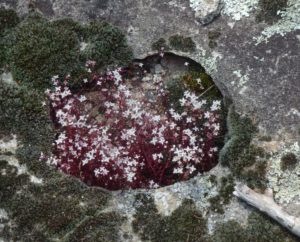
*Orcutt, Gregory A., “Mitchell Mill State Natural Area: A Cultural History,” Department of Natural and Cultural Resources, Division of Parks and Recreation, Falls Lake State Recreation Area, 2015
Text (C) 2021 Betty Lou Chaika, Photos (C) 2021 David and Betty Lou Chaika
Margot Ringenburg
A well-told tale of an underappreciated landscape brought to life by your vivid use of language and wonderful series of photos!
Betty Lou Chaika
Thanks, Margot, for your kind words of appreciation of both landscape and language! Like many other nature writers, I hope that connecting people to places through story will aid in their conservation.
Barbara Stenross
I thoroughly enjoyed the story and am thankful you or David took such wonderful photos. Rocks truly create place, informing the soils they weather into, in concert with local plants and animals. I believe all rocks have energy, and stories to tell. I wonder what the granite flat rocks whisper to the elf opines. Thank you for setting the magic of this place into words.
Betty Lou Chaika
And what do the elf orpines whisper back to the rocks in that conversation between rocks and plants and animals that is the story of the planet? Barb, I am grateful for your love of rocks and your deep understanding of the geology that underpins all life on Earth.
ann loomis
Betty Lou, I’m so glad to be learning more about the NC Piedmont through your writings. You make even small things like lichen seem magical, which of course it is if we would but pay attention. These images are bursting and teeming with life. The interconnectedness of the landscape is a huge lesson for most of us. I’m going to read this piece over and over until it all sinks in. Have you read “Braiding Sweetgrass”? You’d love it!
Betty Lou Chaika
Thanks, Ann, for your enthusiasm to learn more about our local landscapes. Yet, this interchange between rock and lichens and moss is the story about how rocks make soils everywhere. I’m happy you find this as magical as I do! Yes, Braiding Sweetgrass is one of my all-time favorite books, and I’m glad so many people are reading and being affected by it.